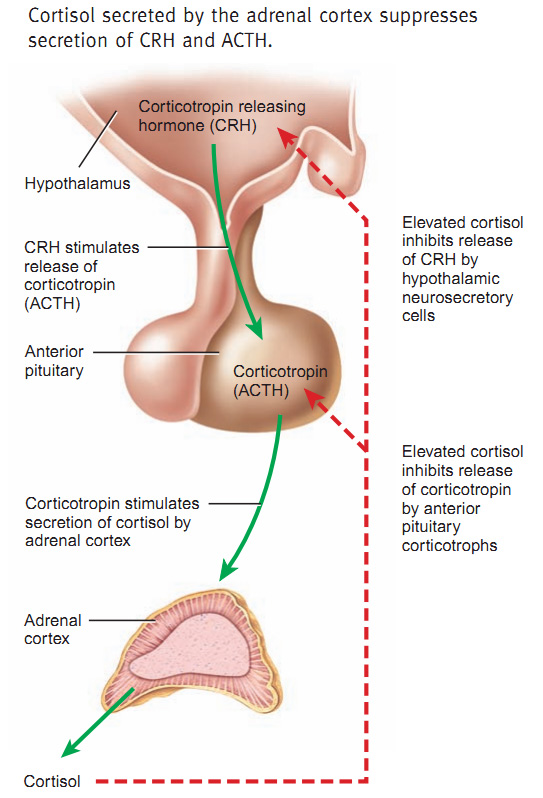The hypothalamus releases the following Releasing Hormones that stimulate the release of different hormones from the adenohypophysis:
- Corticotropin Releasing Hormone (C.R.H. causes the release of ACTH)
- Thyrotropin Releasing Hormone (T.R.H. causes the release of Thyroid Stimulating Hormone aka Thyrotropin)
- Gonadotropin Releasing Hormone (GnRH releases LH and FSH.)
- Growth Hormone R.H. & Growth Hormone I.H.
- Prolactin R.H. & Prolactin I.H.
In this post, we’re concerned with #1.
Let’s break down the word, Adreno-Cortico-Tropin hormone. Tropin means it affects endocrine glands. Adreno refers to the adrenal gland and cortico refers to the cortex( of the adrenal gland). So this is a hormone that affects the adrenal cortex! Very simple! ACTH causes the adrenal cortex to release other hormones! When ACTH is released from the adenohypophysis, it stimulates the Adrenal Cortex to release glucocorticosteroids which affect our blood glucose level.
Examples of glucocorticosteroids released by the adrenal cortex: Cortisol (Cortisone) and Corticosterone.
These things raise the blood sugar level, but how do they raise it? They increase the breakdown of proteins in our body. First the proteins are broken down into amino acids and then they undergo gluconeogenesis, which turn them into sugars.
(Side note: Mineralocorticosteroids are also released from the adrenal cortex that regulate potassium and sodium levels and the most important one is is aldosterone. So is adrenoandrogen, which is like a weaker version of testosterone. Review: Glucocorticosteroids, mineralcorticosteroids and adrenoandrogens are all steroid hormones (lipids) produced from the adrenals. )
Most of the protein in our body is in our muscles in the form of actin and myosin. They are broken down into amino acids, then deamination occurs, and then when you remove that amine group (NH2), you actually form NH3 (Ammonia). Then in your liver, this ammonia is turned into urea which is basically a carbon and oxygen with two amino groups. Your liver releases this urea into the blood stream and it’s the major organic waste carried in our blood stream which is then excreted by your kidneys.
When the amine group (NH2) is removed from the protein, it becomes a ketone acid, which then becomes acetyl sugar. The name of the hormone that causes that to happen is cortisol. We went over all this protein catabolism before, but now you know it’s cortisol that causes this.
Side effects of glucocorticsteroids: The cortisol not only causes the breakdown of proteins into sugars and fats but there are some other really weird actions. At really high levels they have an anti-inflammatory effect and stop cells from releasing ALL chemical mediators of inflammation. The NSAIDs (aspirin, ibuprofen) are not as powerful because they stop the release of ONLY kinins and prostaglandins. The more powerful steroidal drugs stop the release of ALL the chemical mediators. We don’t use the actual natural chemicals as hormones as medicine because our enzymes break them down really quickly. So we use a synthetic mimetic of a glucocorticosteroid, such as prednisone. If given as medicine, it’s not recommended to be taken for a long time because they cause a breakdown of proteins in our body.
Another weird action of cortisol and prednisone is that it acts as an immunosuppressant because it decreases the lymphocyte count, and that’s known as lymphocytopenia. Penia means decrease. Why in the world would someone be given prednisone for the purpose of suppressing the immune system? To prevent organ transplant rejection and also reduce the effects of auto-immune disease.

Excess of glucocorticosteroids: Anytime somebody is oversecreting glucocorticosteroids (maybe due to a tumor in the adrenal cortex or an oversecretion of ACTH, or due to someone taking predinose for an extended period), their entire body changes because their muscles atrophy (due to protein catabolism), and it turns into fat in weird parts, such as between the shoulder blades, the belly, and they get what’s called half-moon face. This is known as Cushing’s Syndrome. So that’s why when somebody has arthritis (inflammation of the joints), it’s not a good idea to take glucocorticosteroids chronically. The NSAID’s have less side effects.
Deficiency of glucocorticosteroids: The opposite of cushing’s syndrome, that is to say, a deficiency of glucocorticosteroids is called Addison’s Disease. Nowadays the proper word that the textbooks wants us to use is hypoglucocorticosteroidism (low levels of glucocorticosteroids).
A major trigger of Corticotropin Releasing Hormone is stress. C.R.H is what causes the release of ACTH (Adrenocorticotropin Hormone) which gets the adrenal cortex to secrete cortisol.
 The model of ALL tropic hormones is a NEGATIVE FEEDBACK LOOP.
The model of ALL tropic hormones is a NEGATIVE FEEDBACK LOOP.
Short Negative Feedback Loop (Short N.F.L.): The increasing cortisol levels cause the inhibition of Corticotropin (ACTH).
Long Negative Feedback Loop (Long N.F.L.): Increasing cortisol levels inhibit the hypothalamus from releasing CRH, which turns off ACTH which stops your adrenal cortex from secreting cortisol.
The reason we don’t suffer form Cushing’s (excess) or Addison’s (deficiency) is because of this feedback loop.
If there’s a problem in the adrenal cortex, that’s called Primary adrenal insufficiency (Addison’s disease) and this occurs when the adrenal glands are damaged and cannot produce enough of the hormone cortisol (and often the hormone aldosterone). Addison’s disease affects one to four of every 100,000 people, in all age groups and both sexes.
If there’s a problem in the pituitary gland, that’s called Secondary adrenal insufficiency and occurs when the pituitary gland fails to produce enough adrenocorticotropin (ACTH), the hormone that stimulates the adrenal glands to produce cortisol. If ACTH output is too low, cortisol production drops. Eventually, the adrenal glands can shrink due to lack of ACTH stimulation. Secondary adrenal insufficiency is much more common than Addison’s disease. The most common cause is a tumor in the pituitary which causes an increase in ACTH which increases the cortisol level. They remove the tumor on the pituitary gland by accessing the pituitary gland through the nose.
Let’s continue by reading how stress affects the cortisol level.






